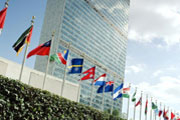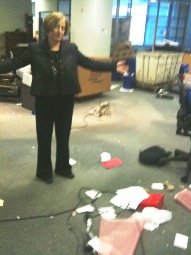UNITED NATIONS - The bustling corridors of the United Nations are quiet. There are no lines in the cafeteria . The campus is being steadily dismantled in the 39-floor high-rise glass tower on New York's East River. And it's no longer any fun.
Completed in 1952, the landmark skyscraper now has water dripping through its roof, asbestos lining the ceiling tiles, a shortage of sprinklers and erratic heating and cooling systems. So it was time for a $1.87 billion overhaul, the costs divided among member states, with the United States paying some 22 percent or $413 million.
Three plans were drawn up in the past decade, each one more expensive than the last, and one is finally coming to fruition.
The skyscraper (known as the Secretariat building) will remain and is being gutted from the inside. Meanwhile, 3,300 of the more than 5,000 people have been relocated, the remainder by the first few months of 2010.
Many are scattered in office buildings around town while Secretary-General Ban Ki-moon and top executives are migrating to a three-story $140 million new building on the north lawn of the complex. Eventually the General Assembly, the Security Council and other conference rooms will move to this building also.
And there they will stay for three years, minimum, more likely five years.
But the human costs are high. Undersecretaries-general who head key departments are to surround the secretary-general in the new office building. However, their staff are scattered around town, some as far as Madison Avenue, five wide city blocks away. Face-to-face interaction between those in political affairs, peacekeeping, and humanitarian affairs, for example, is limited to planned meetings.
And the press is harbored in a library complex on the south side of the campus, a wing off the high-rise. Half have moved, including this reporter, (without TV connections or telephone but with wifi), the other half come early in 2010.
Except for stake-outs at corridors near the Security Council, casual contacts with diplomats and UN officials are disappearing quickly; the attraction of seeing so many people of diverse nationalities in one space is gone.
Wudda, Shudda, Cudda
It didn't have to be this way. The first plan was to take over a little-used park near the UN on 42nd street and build an office complex on it. Once it was complete, staff would be moved in. And once the glass palace was renovated, UN agencies, such as UNICEF or the UN Development Programme, now renting expensive office space in New York, would take over the new building. But that was too logical. The plan was squashed in 2005 by the New York legislature, angry about everything.
Then-State Senator Roy Goodman, a Republican, enlisted an array of distinguished New Yorkers, Democrat and Republican as well as Abraham Foxman, head of the Anti-Defamation League, to support the project, the UN being the city's number one tourist attraction. But in Albany, home of one of the most dysfunctional legislatures in the country, some state senators said UN Secretary-General Kofi Annan had to resign first while others spoke of an anti-Israel bias. Most paid no attention.
Inside the building things got so bad, Mayor Michael Bloomberg forbid New York schoolchildren to visit the United Nations two years ago unless new sprinkler systems and fire-proof doors were installed, many of which took place, costing millions.
The new building will be as green as reconstruction allows. Total energy consumption is expected to be reduced by 50 per cent compared to the present. The carbon footprint will be reduced by over 45 per cent. The consumption of fresh water will be reduced by over 40 per cent. Renovation in the building's basement involves the installation of 14 kilometers of water piping, 65 kilometers of electrical conduits and more than 60 kilometers of telecommunications conduits. An equal amount of deteriorated materials are expected to be removed, representing almost a quarter of the construction activity of the entire project.
In charge of the project, known as the Capital Master Plan, is Michael Adlerstein, a Brooklyn-born former National Park Service architect involved in the preservation of Ellis Island, the Statute of Liberty and the Taj Mahal. He told a recent news conference that the renovation "should last forever," providing there is proper maintenance every 10 to 15 years. "There are buildings that are hundreds of years old that survive very well."
But in a place like the United Nations, renovation is not high on the agenda so it is put off for years, for decades until there is a crisis "where you have to vacate and do it wholesale," he said.


